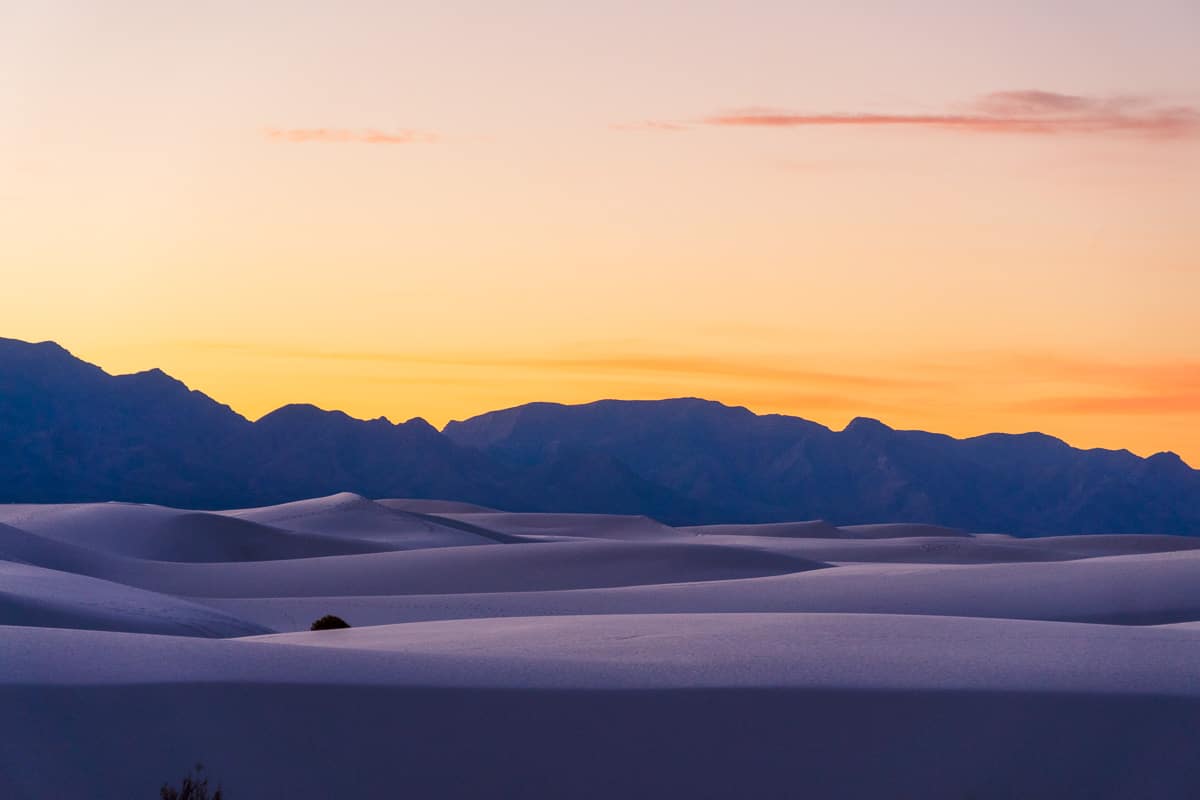White Sands National Park Photography Tips: How to Find and Take Beautiful Photos
Wondering how to get those perfect White Sands National Park Photos?
You always want to go to a white sand beach, well what about some white sand dunes in Southern New Mexico? White Sands National Park’s slogan is “Like No Place Else on Earth”.
With a quick Google search, I really couldn’t find another place with white sand dunes anywhere else in the world. Perfect for photographers looking for unique pictures.
As a photographer, I couldn’t stop clicking away at the surreal photographic opportunities as the color of the sand dunes transitioned from pink to white, orange to blue. One afternoon turned into two days as I couldn’t leave without seeing another sunset. This place is truly magical for both your eyes and your camera.
Here are some of my White Sands National Park photography tips to inspire creative compositions and take the best shots depending on the time of day.
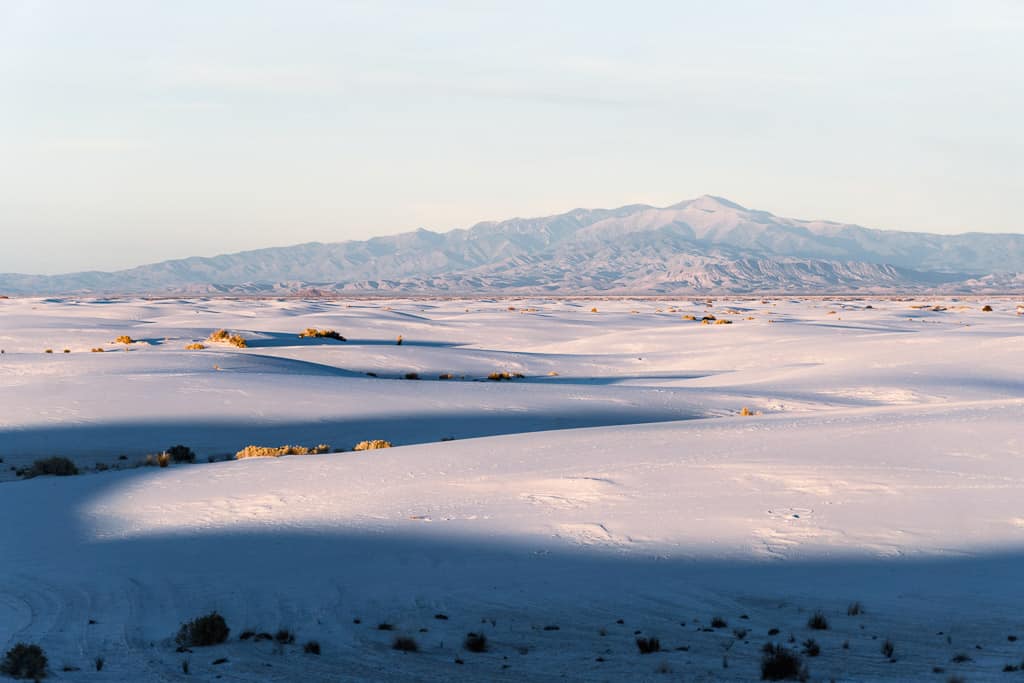
White Sands National Park Photography Tips
Though relatively small in size (227 square miles), photographers can rejoice at the unlimited potential of beautiful pictures one can take here. There are no iconic features, as there is only one feature – the white gypsum dunes.
It is up to you to creatively find the best composition using different lighting, flora, surrounding mountains, and human figures.
Different Times of Day White Sands Photography
White Sands Morning Photography
In general, angular lighting works the best in sand dunes to create contrast. Officially, White Sands National Park is closed most of the year when the sun rises.
Tip! If you want to try getting in at 6:30 am anyway, no one was at the gate that early.
Overall, morning and noon are generally not the best time of day for landscape photography because the lighting is not as dramatic on the dunes. There will still be contrast earlier in the morning but produce softer differences compared to later afternoon. It will be the best time to capture the whiteness of the sand.
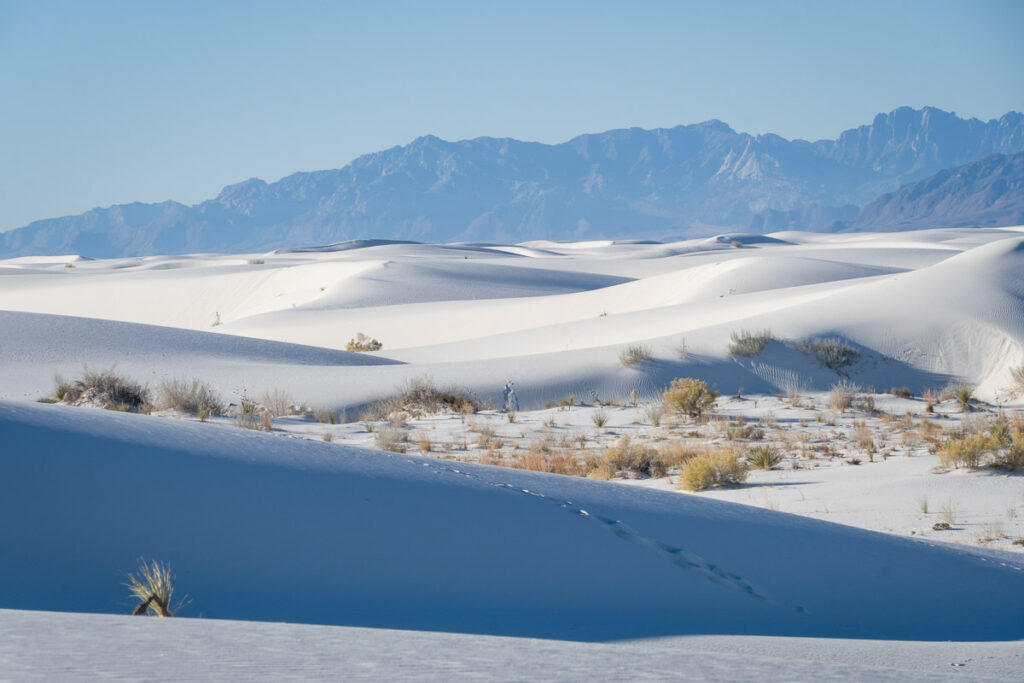
White Sands Midday Photography
Like the morning, photographing in the middle of the day at White Sands National Park can be bland, as there isn’t too much contrast. In addition, there are 291 sunny days in Southern New Mexico, and temperatures get very hot most of the year. With cloudless skies and little shade in the park, staying outdoors for too long can get uncomfortable.
But, I found late morning and midday to be the best time to play around with human subjects as the light contrasts nicely against any colorful clothing and skin tones.
For photos with Human Subjects
- If you have a friend: set the camera to continuous shoot mode. As long as you hold the trigger, photos will continuously take.
- Tripod Setup: Set a countdown timer and choose to take multiple photos within a set period of time (ie 5 photos in 2 seconds). Press the trigger, run to your spot, jump, and hope for the best. It takes trial and error. I think I tried 20 times before being satisfied with the result.
- Why don’t I use a remote trigger? Phone apps and remote triggers exist but usually have a limit of 30 feet before they start glitching…unless you spend the big bucks.
Ensure that your main subject is in focus before packing up for the next spot.
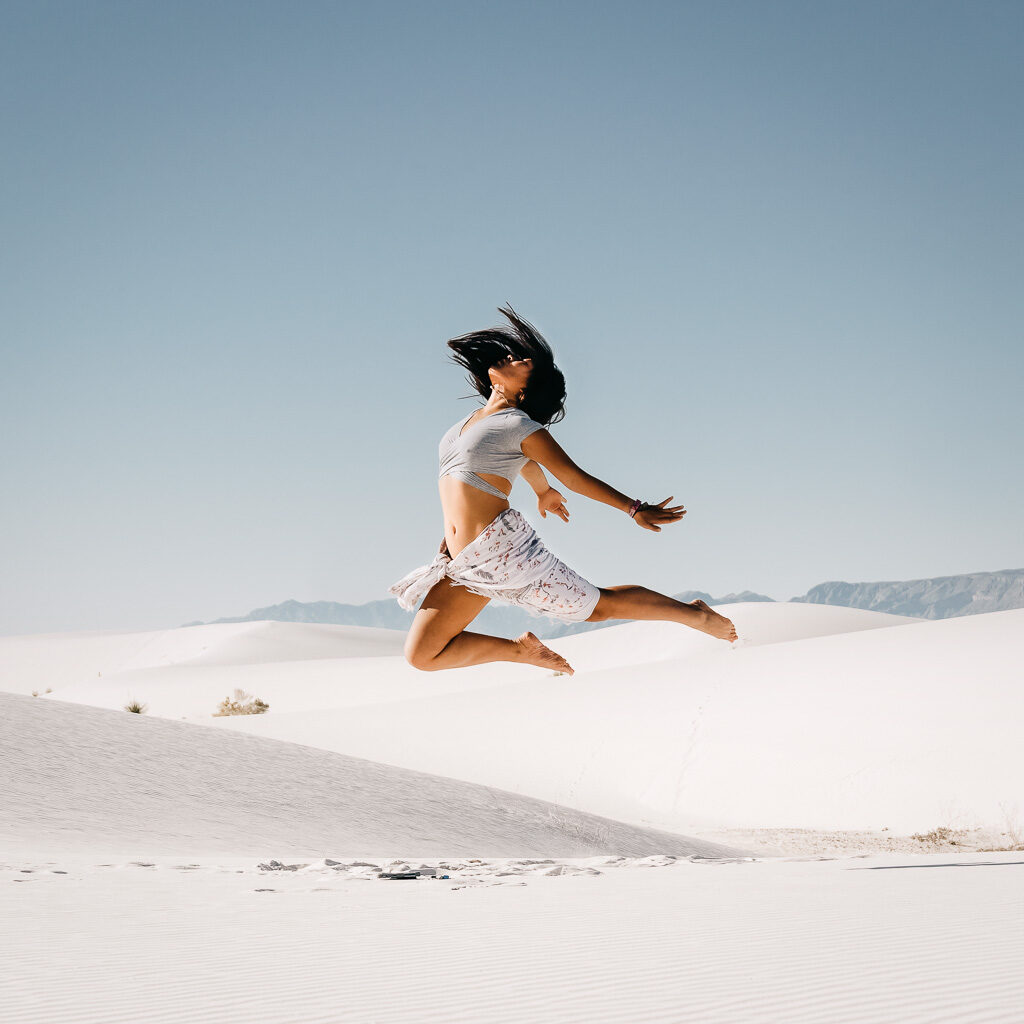
White Sands Late Afternoon Photography
Before golden hour begins, the angular lighting becomes starker but maintains the white hues and blue shadows.
Photography Tip: Find diagonal angles, or blow out the sky on purpose.
In the late afternoon, it is hard to not overexpose your shot as the sun is shining directly into your camera. Like the below example, use this to your advantage to purposely overexpose the sky, while keeping the sand neutral.
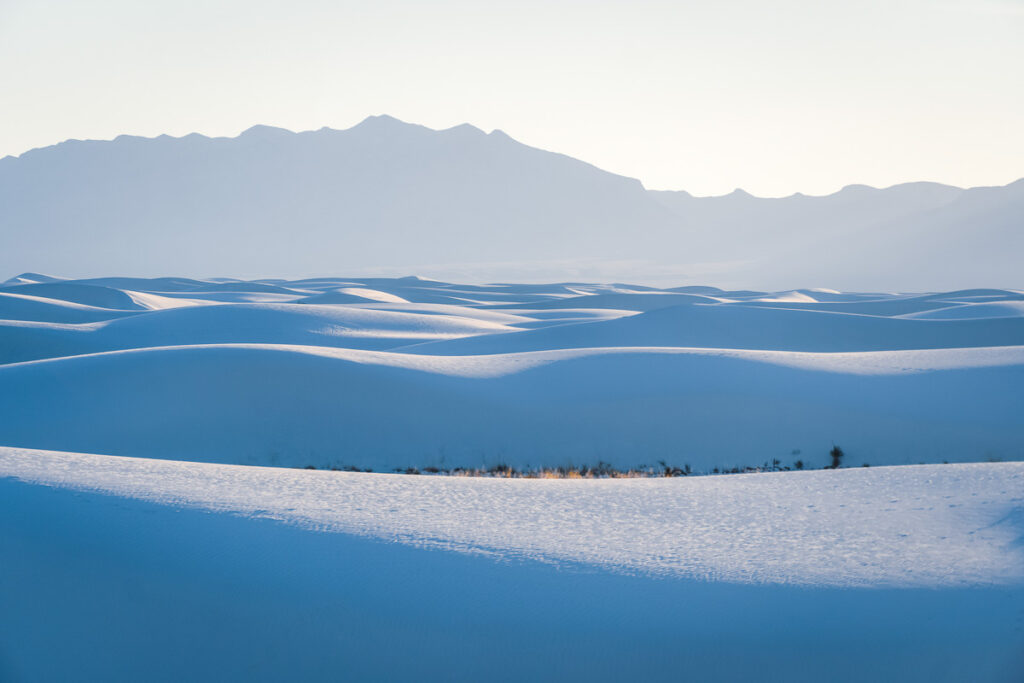
White Sands Golden Hour Photography
Hands down, golden hour is the best time to take great photos at White Sands National Park. As the sun lowers closer to the horizon, the shadows of White Sands dunes stretch out magnificently, as the color of the dunes turns from white to orange.
Large landscape shots are especially striking when you add a human for scale.
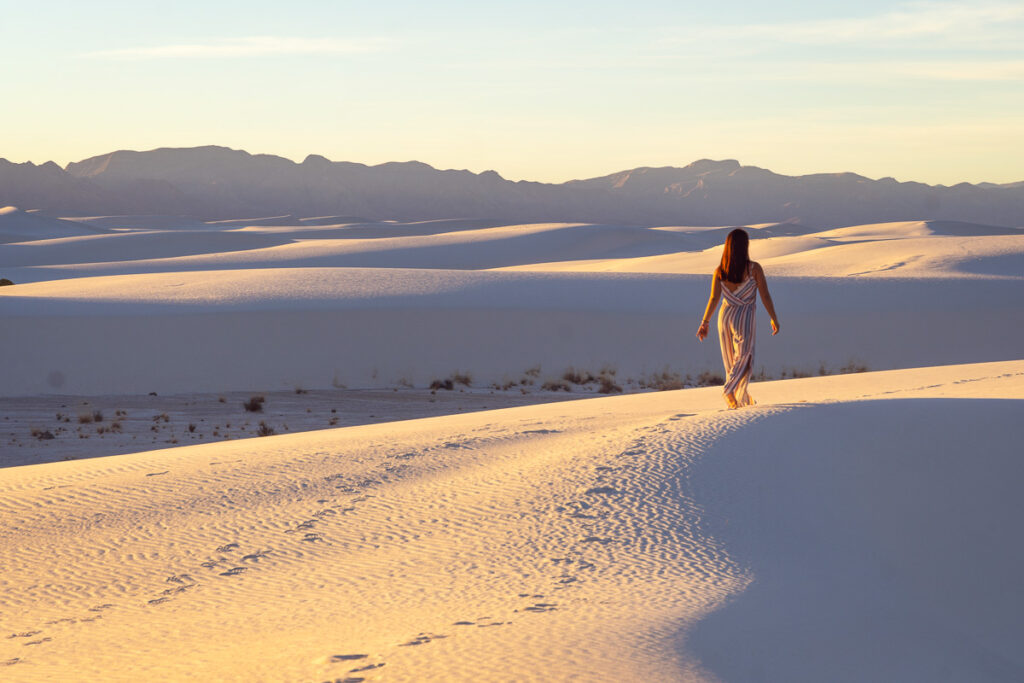
White Sands Sunset Photography
Of course, sunsets are always a fan favorite everywhere. Even though White Sands showcases incredible sunsets for your eyes, I actually found it quite hard to shoot at this time of day. The sky was always blown out by the sun, and the San Andres Mountains, which face the sunset, are closer and more grand than those in the Eastern direction.
If you wait until after the sun dips below the mountains, then the difference in exposure between land and sky becomes more manageable.
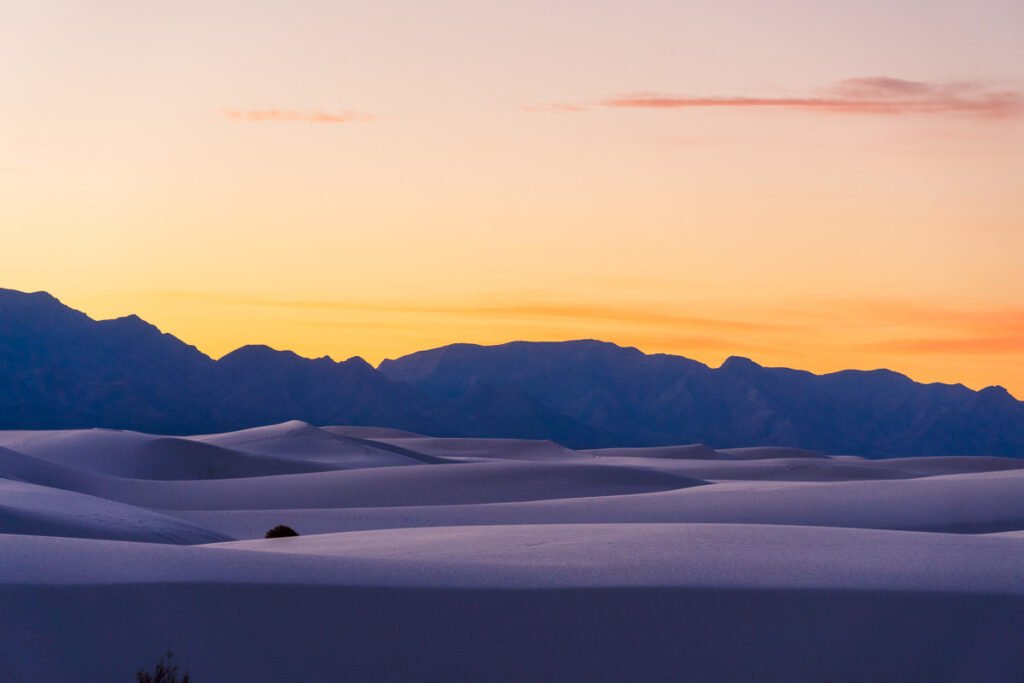
White Sands Blue Hour Photography
Don’t leave once the sun disappears into the horizon! Watch the entire scenery transition into a new mood post-sunset in a time of day aptly named blue hour. Stay at least for the next 30 minutes as the color of the sand mimics the shading of the sky and turns a purple-blue hue.
It is gorgeous and 100% worth waiting for. At worst, hike back in the dark; at least there is nothing to trip over.
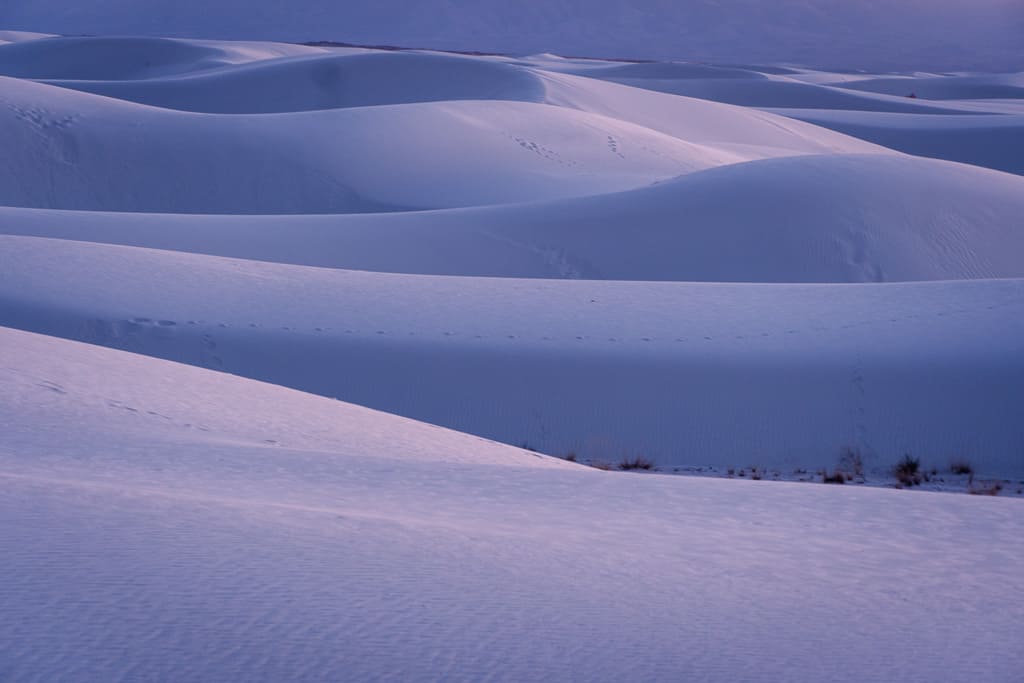
White Sands Night Photography
Unfortunately, park rangers will ask visitors to leave before it gets to be pitch black, so no galaxy or full moon photos this time. Nighttime brings an even darker blue, so focusing on the sand dune’s ripples and waves stands out against the dark sky. You will definitely need a tripod and at least a little bit of moonlight.
Is Sunrise or Sunset Better at White Sands National Park?
100% sunset is better.
The sunrise was beautiful, but sunsets are much more impressive at this park. Aside from the fact that the park is not officially open at sunrise, the sunset transitions through many more phases, each bringing a unique opportunity of lighting to play with.
Where to Take the Best Pictures in White Sands National Park
You hate to hear this, but there is no best place. The further you walk into the sand dunes, the fewer footprints there are. Once you leave Dunes Drive, if you go one or two dunes over, it already feels otherworldly. If you walk half a mile out, you can find untouched rolling dunes more easily.
The first half of White Sands National Park’s road features more plant life, while the second half is more barren but has cleaner white dunes. A few set hikes were created by the National Park Service, like Alkali Flat Trail, Playa Trail, and Dune Life Nature Trail.
Still, I found it more fun to drive to the Dune Road loop end and just wander into the heart of the dunes myself. There is more minor sand dune disturbances this way.
In general, the west is nicer to shoot any time of day since the San Andres Mountains in the background really made the pictures pop. There were also mountains in the east, but aside from sunset time, they were further away, making them look not as impressive in shots.
Subjects to Photograph in White Sands National Park
Playing with the lighting is the groundwork for capturing amazing White Sands National Park photography. However, there are other photographic subjects to experiment with too.
Desert Plants
There is more plant life in the first half of Dunes Drive and less in the second half. Strewn all over the park, a unique variety of plant called Yucca plants sit straight on top of the dune. These plants have evolved root systems to grow taller with the shifting height of the sand dunes and collapse under their own weight once the dune has passed through.
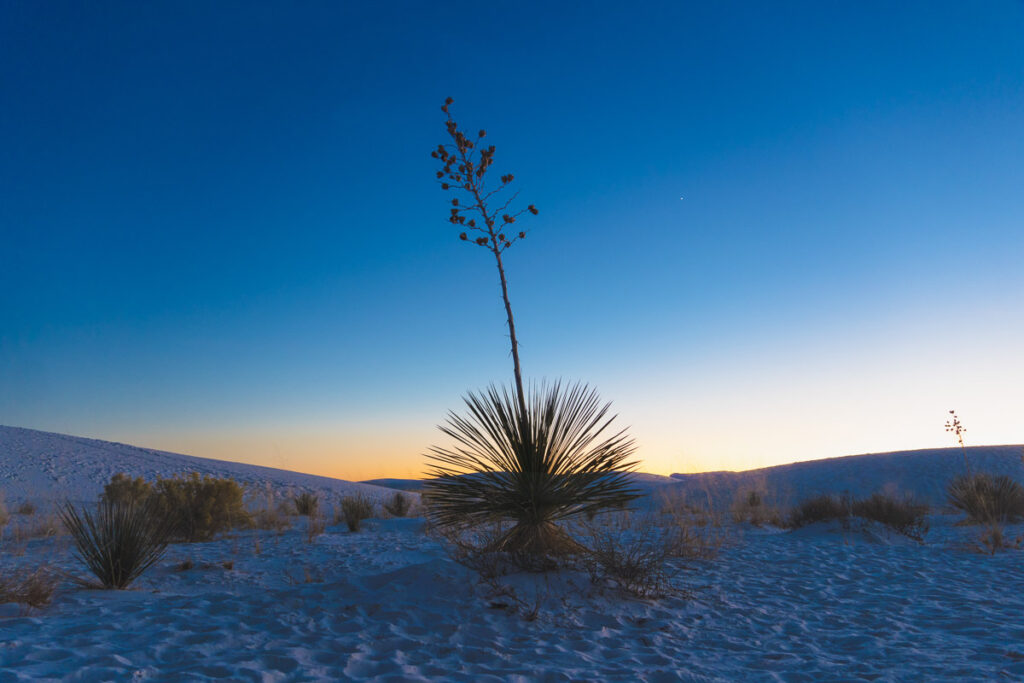
Humans to Add Scale
Including small-scale humans in the great expanse of the dunes grounds your photo by drawing people’s eyes to a subject while showing off the beauty of the landscape.
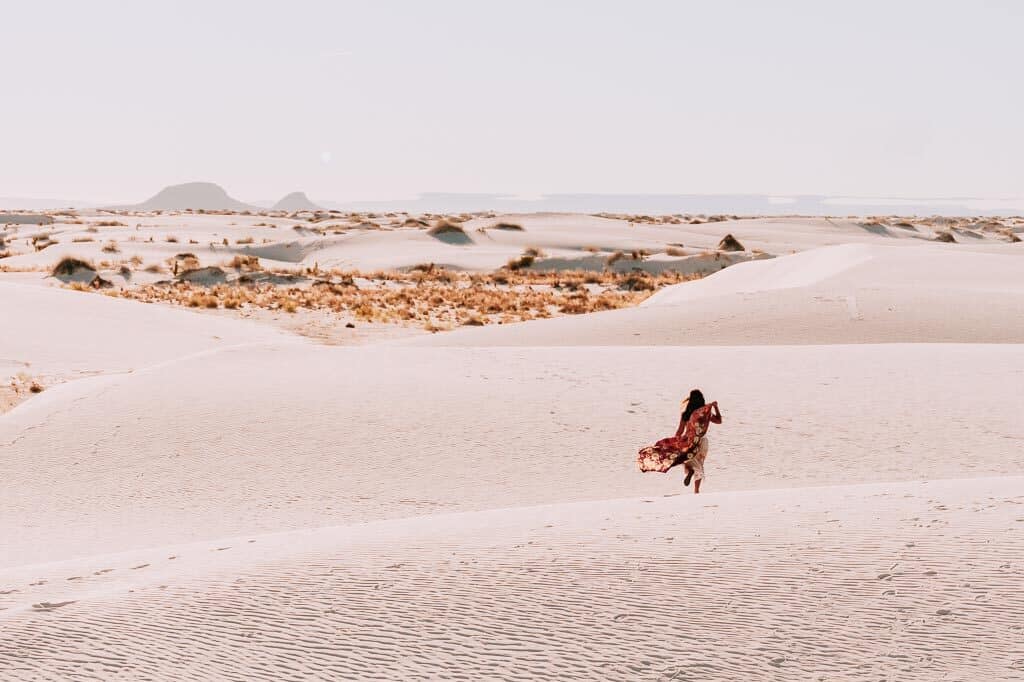
Panoramic Dune Shots
Climb over a few dunes, and you’ll realize that you are 360 degrees surrounded by white sand. If you can’t decide which perspective to shoot from, why not capture it all in a cinematographic panoramic shot.
Some cameras automatically stitch together multiple photos, like the iPhone or some Nikon and Canons. Otherwise, software editing tools like Photoshop have an automatic stitching functionality under File>Automate>Photomerge. Photoshop will analyze the photos you select and automatically attempt to stitch at the best locations, but you can always adjust later.
Fun Photoshop Tip: If you use Photomerge with two completely different photographs, you may get unique results.

Figure Silhouettes
One of my favorite techniques, creating silhouettes involves having strong backlighting to darken the foreground to essentially black. For this to work, there should only be light coming from one direction, then face your camera directly at it.
At White Sand National Park, try to create dramatic human or plant figure silhouettes, especially during post-sunset times.
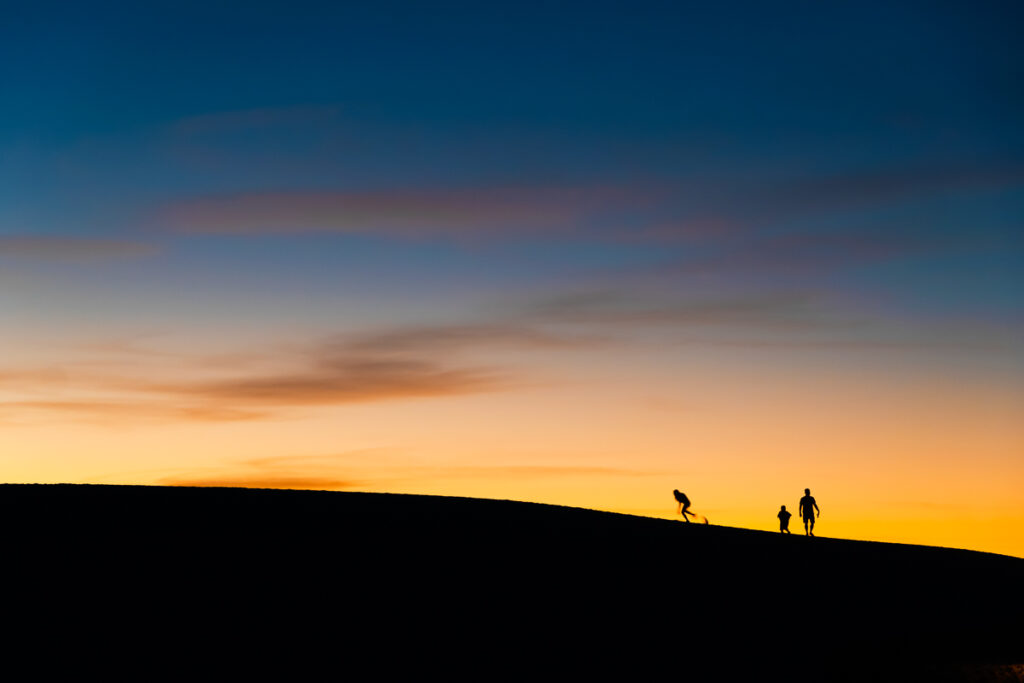
The Dunes Unique Patterns (Ripples)
Once you leave the footprints disturbed by human interference behind you, you will see ripples formed by the wind zigzag along the plains, creating wave-like patterns to focus on.
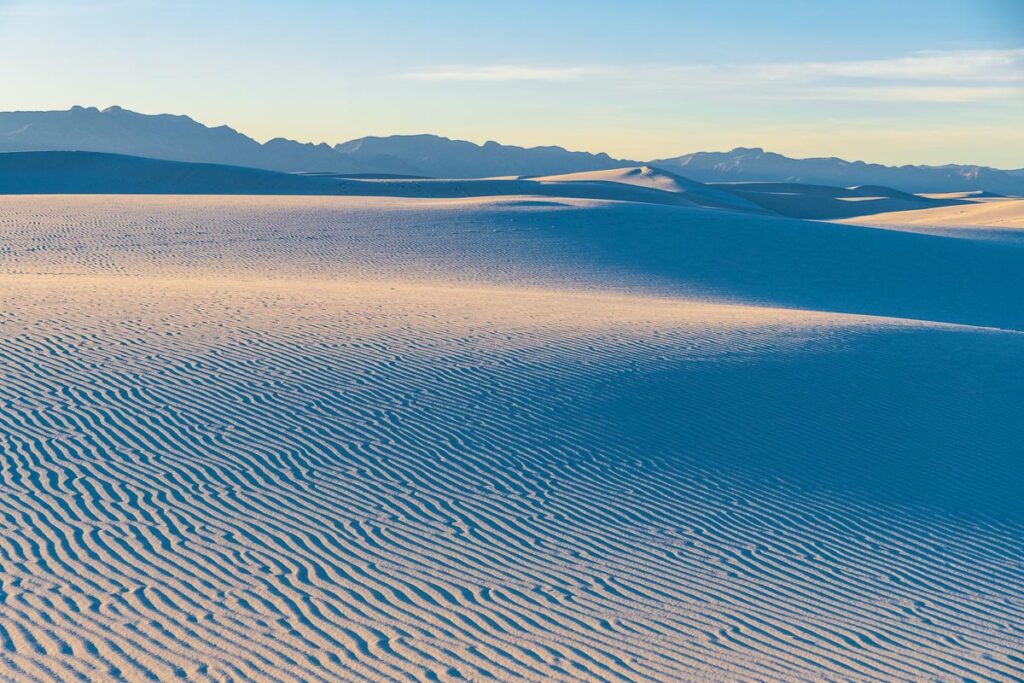
Valley Flats
At the valleys of some dunes, you may have stepped on rougher patches of sand, a different texture from the surrounding fine gypsum.
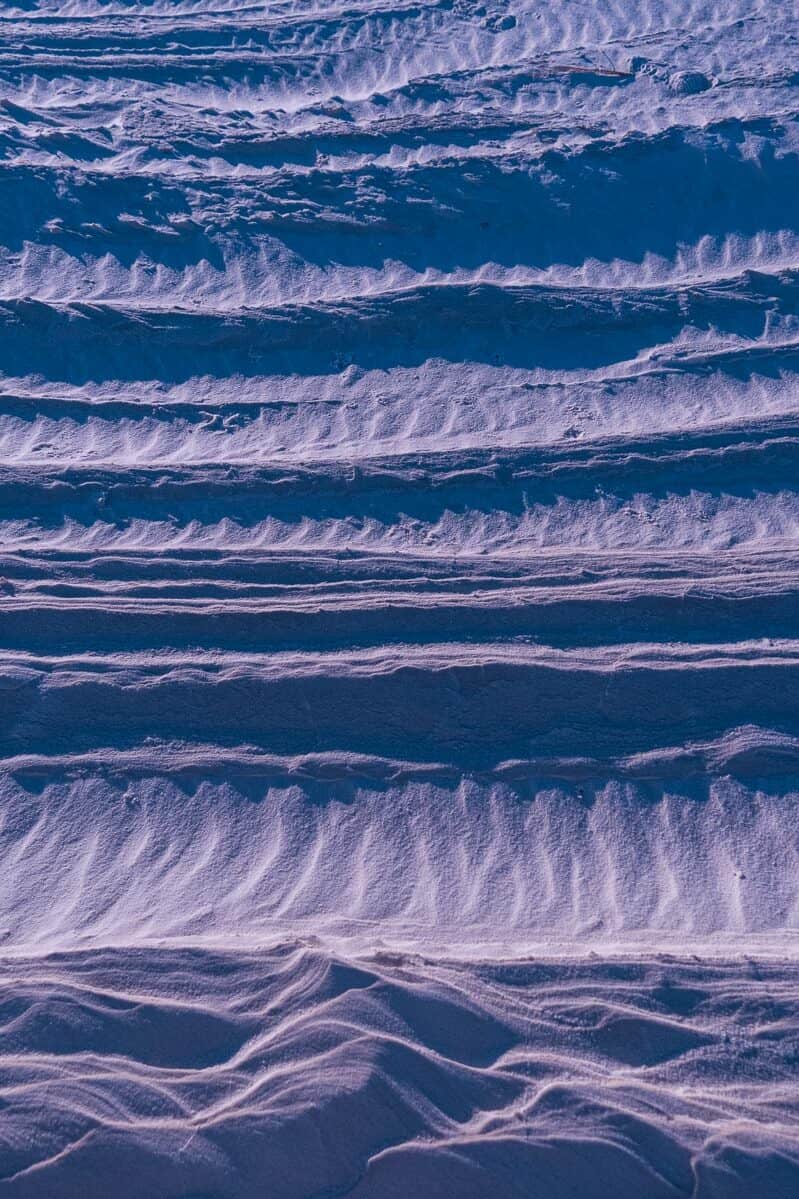
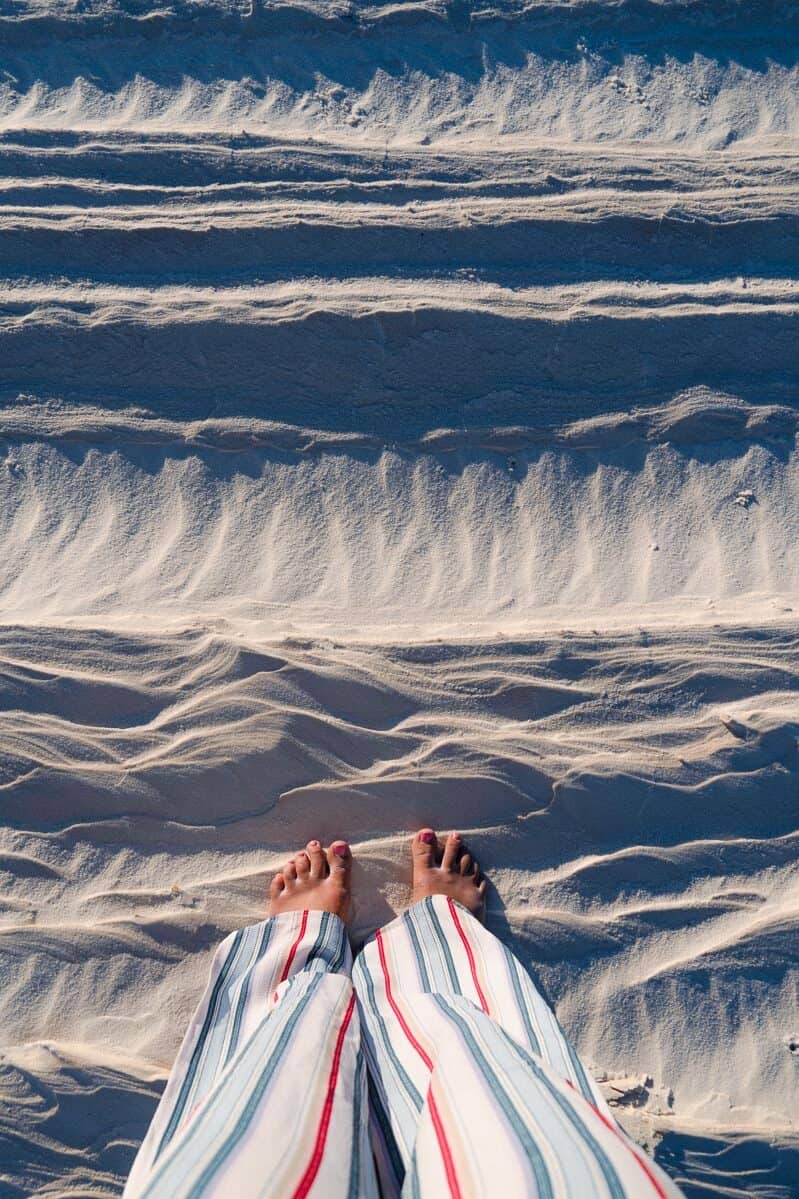
Black and White
Try taking the same picture and making it black and white. The vibe completely changes.
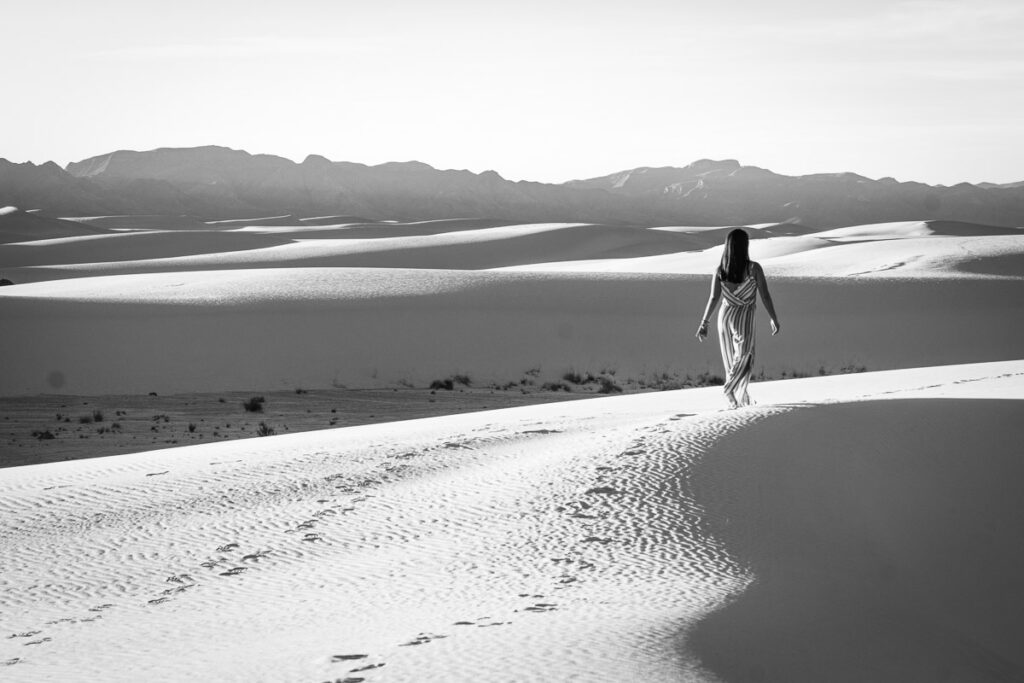
A Bit About White Sands National Park
The White Sands National Park, New Mexico, USA. White Sands National Park (formally White Sands National Monument) is one of America’s most recently named National Parks, officially joining the party in 2019. Despite its relatively small size, this magical road trip stop left me speechless.
Sitting in the Tularosa Basin, the dunes of White Sands National Park are made of gypsum crystals, giving the wondrous formations their white color. Unusual for gypsum to accumulate together, the basin allows the minerals to collect into rolling dunes that are shifting day by day. This creates the world’s largest white gypsum dune field.
Fun Fact: White Sands National Park is a small subsection of White Sands Missile Range, a military testing area operated by the United States Army.
Basic White Sands National Park Information
- Address: 19955 US-70, Alamogordo, NM 88310
- Size: 145,762 acres (589.9 km²)
- Park Closures: Open Year-round
- Entrance Fee: $25 per vehicle; $20 per motorcycle; $15 per individual; $80 Interagency Annual Pass
The drive from the nearest city, Alamogordo, to White Sands entrance station takes just 20 minutes, while from El Paso, New Mexico, it’s a 1.5-hour journey.
From the highway, you can not yet see these white shifting dunes. After entering the park, you’ll find the visitor center on your right.
During winter, park hours are limited from 7 am to 6 pm. Rangers tend to start kicking visitors out about 30 minutes prior to closing time.
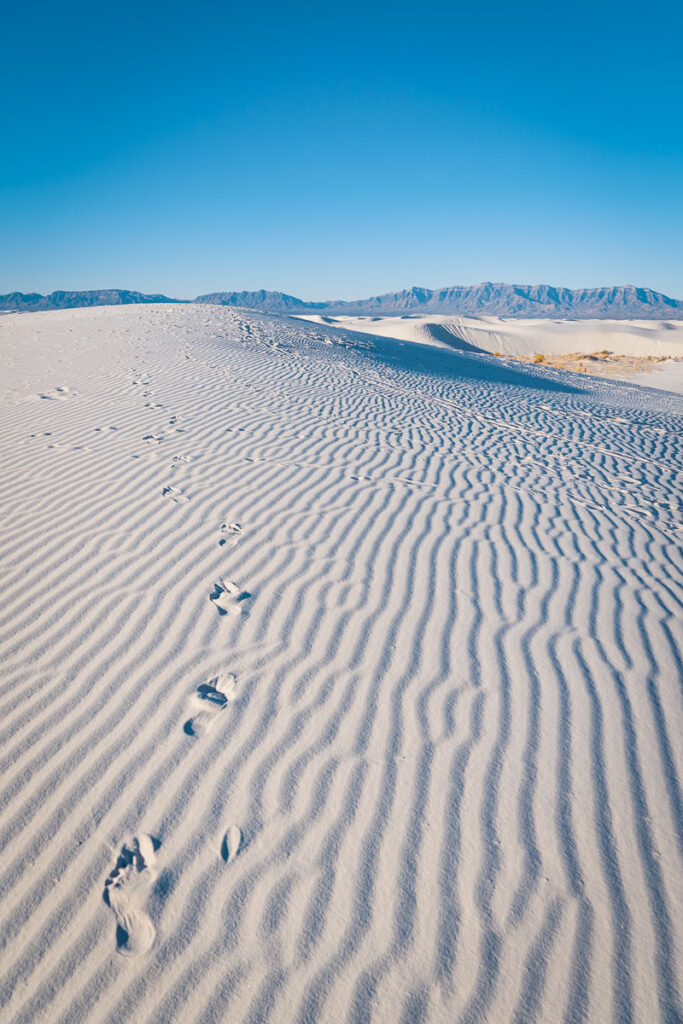
Tip: Early entry is not permitted, but National Park Service rangers don’t operate the gate before official opening hours. Might as well shoot your shot to get in for the sunrise.
Things to Do from the White Sands National Park Visitor Center
- Move about the Dunes: Visitor Center plays a 7-minute movie every 30 minutes (9am to 5pm)
- Sunset Stroll: At least in November, you meet at 4pm at a designated sunset meetup point for a ranger to take a walk and explain the geology and other educational information
- Sleds: Rent sleds from the visitor center for $5 to sled down the dunes
If you aren’t into photography, then 2 hours is plenty of time at White Sands National Park if you don’t plan to do the sunset tour or have a picnic. Although striking, the only thing to do here is get lost in the sand dunes, climbing up and sledding back down.
Final Thoughts: White Sands National Park Photography Tips
As with any art medium, don’t be scared to experiment. I ended up taking more than 500 pictures in two days at White Sands National Park (mainly because I shot selfies, aka pressing the trigger and running away before the countdown ended).
At the scene, play around with the lighting and compositions available. On your photo editing software, try different lighting tones or desaturation, high contrast, or otherworldly manipulations.
Hope this White Sands National Park photography guide gives some inspiration on how to take beautiful white sands photos!
| TRAVEL RESOURCES |
| ✈️ Find the best tours and activities with Viator to cross off your bucket list and create unforgettable memories 🏘️ Book your accommodation with Booking.com in advance and check availability on the days of your travels. 🧾 Rent a car in advance with Discovercars for those epic road trips at the best price. 📓 Safety first! Insure yourself with Safety Wings nomad travel insurance for $45/month for all your adventures and activities abroad. |

